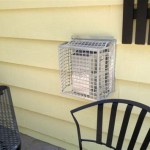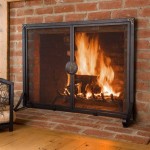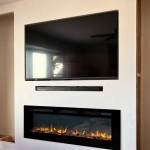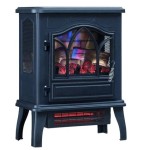How To Clean Soot Off Fireplace Walls
Fireplaces, while adding warmth and ambiance to a home, inevitably produce soot as a byproduct of burning wood or other fuel. This soot, a fine black powder composed primarily of carbon, adheres to fireplace walls, creating an unsightly mess over time. Regular cleaning is essential not only for aesthetic reasons but also to prevent the buildup of soot, which can pose a fire hazard if left unchecked. This article provides a detailed guide on how to effectively clean soot off fireplace walls, ensuring a safe and visually appealing hearth.
Before commencing any cleaning procedure, safety precautions are paramount. Soot can be irritating to the skin and respiratory system. Goggles are necessary to protect the eyes from falling soot, and a dust mask or respirator is crucial to prevent inhalation of airborne particles. Rubber gloves shield hands from direct contact with soot and cleaning solutions. Furthermore, it is advisable to wear old clothing or coveralls, as cleaning soot can be a messy undertaking. Proper ventilation is also critical; open windows and doors, or use a fan, to ensure adequate airflow during the cleaning process.
Preparation and Materials
Effective soot removal necessitates the right tools and cleaning agents. Prior to commencing the cleaning process, gather the following materials: a stiff-bristled brush (a masonry brush is ideal for brick fireplaces), a vacuum cleaner with a hose attachment and HEPA filter (to capture fine soot particles), a sponge, two buckets (one for clean water and one for the cleaning solution), trisodium phosphate (TSP) or a suitable alternative cleaning agent, and protective gear (goggles, dust mask, gloves, and old clothing).
The choice of cleaning agent depends on the fireplace wall material. For brick fireplaces, a solution of TSP dissolved in warm water is generally effective. However, TSP can be harsh and should be used with caution, particularly on painted surfaces. Alternatives include dish soap diluted in warm water or commercially available fireplace cleaner specifically designed for soot removal. Test the cleaning solution on an inconspicuous area first to ensure it does not damage or discolor the surface.
Once the materials are assembled, prepare the work area. Cover the floor around the fireplace with drop cloths or old newspapers to protect it from spills and falling soot. This will minimize the amount of cleanup required after the fireplace walls are cleaned.
The Cleaning Process: A Step-by-Step Guide
The cleaning process involves several distinct stages, each contributing to thorough soot removal. Begin by dry-cleaning the fireplace walls. Use the stiff-bristled brush to loosen the soot particles adhering to the surface. Brush in a downward direction to prevent soot from spreading upwards. Pay particular attention to areas with heavy soot buildup, such as the firebox and around the opening.
Next, vacuum the loosened soot using the vacuum cleaner with the hose attachment. Direct the hose nozzle along the walls, carefully capturing the soot particles dislodged by the brush. The HEPA filter is essential for trapping fine soot particles and preventing them from being recirculated into the air. Vacuum thoroughly, overlapping each pass to ensure complete soot removal. Empty the vacuum cleaner bag or canister frequently to maintain suction efficiency.
Following the dry cleaning stage, prepare the cleaning solution. Mix TSP or the chosen alternative with warm water according to the manufacturer's instructions. Soak the sponge in the cleaning solution and wring it out thoroughly to avoid excess moisture. Gently scrub the fireplace walls with the damp sponge, working in a circular motion. Apply light to moderate pressure to remove stubborn soot stains. Rinse the sponge frequently in the clean water bucket to prevent re-depositing soot onto the surface.
After scrubbing the entire surface, rinse the fireplace walls with clean water. Use a separate sponge or cloth dampened with clean water to remove any remaining cleaning solution residue. Repeat the rinsing process until all traces of the cleaning agent are gone. This step is crucial to prevent the cleaning solution from damaging the surface or attracting more soot in the future.
Special Considerations and Troubleshooting
Certain types of fireplace walls may require specialized cleaning techniques. For painted fireplace walls, avoid using abrasive cleaners or harsh scrubbing, as this can damage the paint. Instead, opt for a gentle cleaning solution and a soft sponge. If the paint is heavily stained with soot, consider repainting the fireplace walls after cleaning.
For stone or textured fireplace walls, a pressure washer can be used to remove stubborn soot stains. However, exercise caution and test the pressure washer on an inconspicuous area first to ensure it does not damage the surface. Use a low-pressure setting and avoid directing the nozzle too close to the surface. Allow the stone or textured material to dry completely after pressure washing.
In cases of severe soot buildup, multiple cleaning sessions may be necessary. Repeat the cleaning process as needed until the fireplace walls are clean and free of soot. For extremely stubborn stains, consider using a specialized soot remover or consulting with a professional cleaning service.
After cleaning, allow the fireplace walls to dry completely before using the fireplace. This will prevent the newly cleaned surface from absorbing moisture, which can attract soot and other contaminants. It is also advisable to inspect the chimney and flue regularly to ensure they are free of obstructions and in good working order. A clean chimney and flue will help prevent the buildup of soot and reduce the risk of chimney fires.
Regular maintenance, including annual chimney sweeps and periodic cleaning of the fireplace walls, is essential for keeping the fireplace in optimal condition. By following the guidelines outlined in this article, homeowners can effectively remove soot from fireplace walls, ensuring a safe, clean, and aesthetically pleasing hearth for years to come.

Clean Soot Fireplace From Stone Furnace Oil Leaks Diesel Spills Gas Remediation

How Fo I Remove Fireplace Soot Smoke Hometalk

How To Clean Fireplace Bricks Simple Practical Beautiful

Clever Ways To Clean Soot Off Walls

Cleaning Soot Above Your Fireplace

How To Clean Up Soot After Fire Damage Jenkins Restorations

4 Ways To Clean Soot From Brick Wikihow

How To Clean Soot Off Walls In A And Effective Way

How To Clean Fireplace Brick Soot Marks And Grime Hometalk

Soot Stain Removal Guide
Related Posts








